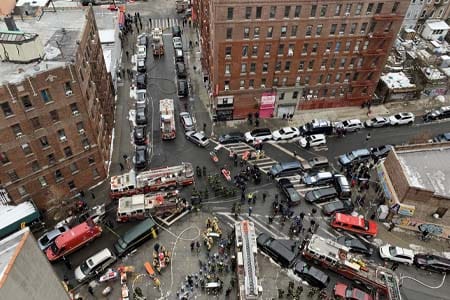Create safer communities by implementing and enforcing codes and standards, especially in the WUI and under-served and vulnerable populations, and provide affordable and fire-safe housing.
Issue: State and local governments are responsible for promoting the use and enforcement of current codes and standards. The federal government can help by incentivizing compliance and providing funding to local jurisdictions for code implementation, inspection and enforcement. This will increase fire and life safety in our communities, especially in the WUI and among underserved and vulnerable populations.
Impact areas
Model building codes improve building resilience to natural disasters and save $11 for every $1 invested.1
All nationally recognized modern building and fire codes require the use of life-saving technology like smoke alarms, carbon monoxide alarms and automatic fire sprinkler systems.
Nearly a million households live in public housing units in the United States,2 and fire safety improvements in public housing must receive heightened attention. In 1992, Congress passed the Federal Fire Safety Act (15 USC 2227), requiring newly constructed multifamily housing units to have fire sprinklers. HUD estimates that approximately 570,000 multifamily public housing units that were constructed before the sprinkler requirement are in their inventory. A significant portion of these units lack the protection offered by fire sprinklers.
In buildings with automatic fire sprinkler systems, the civilian fire death rate is 89% lower than nonsprinklered buildings and the injury rate is 27% lower. Furthermore, property damage decreases significantly in buildings protected by fire sprinklers.3 Investments must be made in retrofitting public housing with fire sprinkler systems.
Nearly 3 out of 5 home fire deaths are caused by fires in properties without smoke alarms or smoke alarms that failed to operate.4 HUD must provide resources to public housing authorities to either retrofit housing units with hardwired smoke alarms or require the installation of tamper-resistant long-life battery-powered smoke alarms.

Philadelphia Fire Department (PFD) units operating at January 2022 multifatality fire in the city's Fairmount neighborhood.
Photo credit: PFD Community Action Team
Jan. 9, 2022: Bronx, New York: New York City Fire Department (FDNY) units operating at the Twin Parks Fire. Tragically, 17 people died at this fire. However, many more were rescued by the FDNY.
Photo credit: Frank Leeb- 1 Natural Hazard Mitigation Saves: 2019 Report (National Institute for Building Sciences; Dec. 1, 2019)
- 2 U.S. Department of Housing and Urban Development, Office of Public and Indian Housing
- 3 U.S. Experience with Sprinklers (NFPA; October 2021)
- 4 Smoke Alarms in US Home Fires (NFPA; February 2021)
